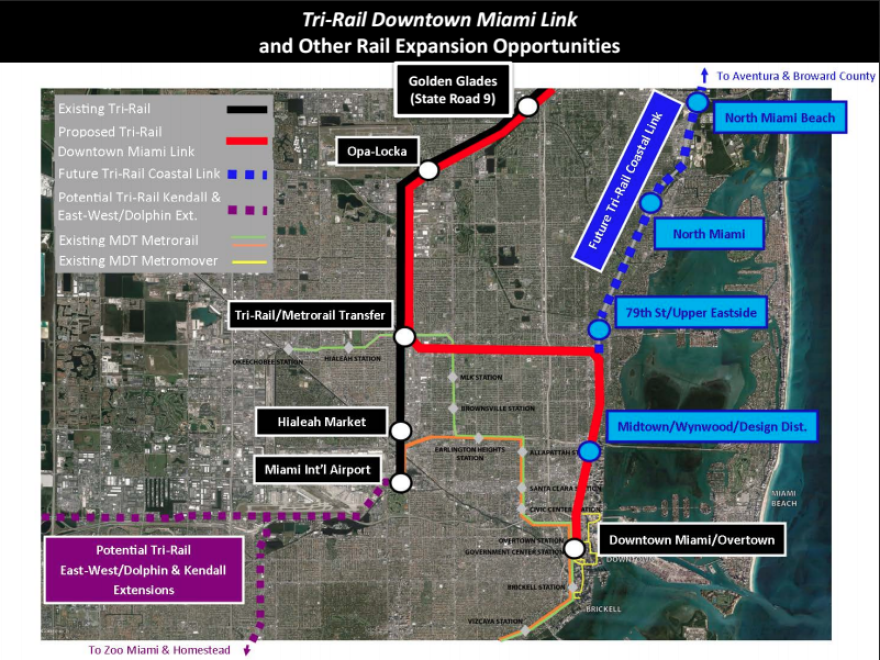A planned Tri-Rail station in downtown Miami came one step closer to fruition on Tuesday, when the Miami-Dade County Board of Commissioners voted unanimously to approve $13.9 million in funding for the project.
The grant will help fund the construction of two Tri-Rail platforms atAll Aboard Florida’s MiamiCentral complex, currently under construction by the Government Center. The complex will also host All Aboard Florida’s passenger trains to Orlando, as well as restaurants, stores, apartments, and office spaces.
The Tri-Rail is a commuter rail service that connects West Palm Beach to Miami. Owned and operated by the South Florida Regional Transportation Authority, the line’s last southbound stop is at Miami International Airport. Commuters to downtown may switch to the Metrorail’s green line at Northside Station on 79th Street, but planners contend that the need to switch trains dissuades many potential commuters.
Jack Stephens is the executive director of the Tri-Rail.
“It’s going to be an incredible opportunity to serve the downtown of Miami, to get people out of their cars, and to show people that there is another option for getting into and out of town,” Stephens says.
Planners expect the downtown Tri-Rail platforms to be operational in 2016.

However, Tri-Rail and South Florida officials also see the move to downtown Miami as an essential first step in a long-term transportation plan for the metro area. Tri-Rail hopes the downtown station will serve as an anchor for a second Tri-Rail line, called the Coastal Link. This line will eventually run along the coast on the Florida East Coast Railway track and serve coastal communities including North Miami, North Miami Beach, and Aventura. Tri-Rail hopes to implement the plan by 2020.
Stephens says that for Tri-Rail, the ability to build platforms at MiamiCentral is an optimal economic opportunity. He says sharing a space with All Aboard Florida will save money for Tri-Rail and local government funders, since the project will not need to purchase land downtown for a separate station.
Tri-Rail’s expansion has garnered significant support from South Florida officials. Miami-Dade County Mayor Carlos Giménez says that the construction of Tri-Rail platforms downtown is a necessity.
“This is a once in a lifetime opportunity,” says Giménez. “The great thing about this Tri-Rail station is having a Tri-Rail station at what’s going to be our central station. Where you have All Aboard Florida, where you have the bus station, where you have MetroRail, where you have MetroMover, all in one place. We really need to have that station here.”
Palm Beach County Commissioner Steven Abrams is a board member for the SFRTA, and he shares Giménez’s enthusiasm about the Tri-Rail project. Abrams cites alleviation of traffic and economic advantages as primary incentives for Tri-Rail’s development.
“It would be a great boon to Miami. For instance, I came down here today, driving. If I had been able to take the train from West Palm Beach, it would be one fewer car on the roads here in Miami,” Abrams says. “It also will give opportunities to Miami-Dade residents to travel up to Broward and Palm Beach Counties for job opportunities and other activities. And you have people who will be coming down and spending money in Miami for the benefit of the local economy. It’s going to be a convenience for everyone.”

Miami-Dade County represents just one of several funding sources for the Tri-Rail project. Tri-Rail is seeking a total of $69 million for the project from local and state government sources.
Tri-Rail faces two important funding decisions next week, from the City of Miami and the Southeast Overtown/Park West Community Redevelopment Agency.
Even so, Stephens is confident.
“Even since the early days, most people quickly buy into the vision. They see the need, they see the opportunity, and they know that it’s here now and it won’t come again,” Stephens says.





